Evaluation of Sputtered Mo–Cu–Cr–N Coatings Prepared at Different N2 Gas Flow Rates Using a Multicomponent Single-Alloy Target
Abstract
1. Introduction
2. Materials and Methods
2.1. Coating Deposition
2.2. Coating Characterization and Friction Tests
3. Results and Discussion
3.1. Microstructure
3.2. Crystal Structure
3.3. Composition
3.4. Mechanical Properties
3.5. Friction Behavior
3.6. Corrosion
4. Conclusions
- SEM and XRD analyses revealed that the coatings prepared at low nitrogen flow rates (0 and 3 sscm of N2 gas rate) had a columnar structure with no nitride phases. In contrast, the coatings prepared at nitrogen flow rates of 6–18 sccm had a featureless and dense coating structure.
- In the coating prepared at a gas ratio of Ar: N2 = (24:12), all the Mo and Cr formed nitride phases; thus, this flow rate was determined to be optimal. However, when nitrogen was added in excess at a flow rate of 18 sccm, broad peaks indicating an almost amorphous structure were observed in the XRD patterns.
- The Mo–Cu–Cr–N coating prepared at a gas ratio of Ar: N2 = (24:12) had a high hardness value (30.4 ± 1.2 GPa) and the highest fracture toughness value (>0.1) because of the formation of crystalline (Mo,Cr)2N phases.
- The stabilized coefficient of friction was approximately 0.003 for the samples prepared at a gas ratio of Ar: N2 = (24:12), confirming the low friction characteristics of the coatings in a lubricating PAO environment. The surface roughness values before and after the friction tests were mostly unchanged, confirming the excellent wear resistance.
- The lowest potential voltage and the highest corrosion current were obtained for the uncoated substrate and the coating prepared at a gas ratio of Ar: N2 = (33:3), which has a columnar coating structure and poor mechanical properties, revealing their low corrosion potentials and poor protective efficiency.
- The highest corrosion potential and protective efficiency were obtained for the sample with a prepared gas ratio of Ar: N2 = (24:12), due to containing a highly crystalline Mo2N phase with a grain size of approximately 6 nm, as well as a Cr2N phase, and a fine nanocomposite microstructure.
Supplementary Materials
Author Contributions
Funding
Institutional Review Board Statement
Informed Consent Statement
Data Availability Statement
Conflicts of Interest
References
- Huang, J.-H.; Lau, K.-W.; Yu, G.-P. Effect of nitrogen flow rate on structure and properties of nanocrystalline TiN thin films produced by unbalanced magnetron sputtering. Surf. Coat. Technol. 2005, 191, 17–24. [Google Scholar] [CrossRef]
- Elangovan, T.; Kuppusami, P.; Thirumurugesan, R.; Ganesan, V.; Mohandas, E.; Mangalaraj, D. Nanostructured CrN thin films prepared by reactive pulsed DC magnetron sputtering. Mater. Sci. Eng. B 2010, 167, 17–25. [Google Scholar] [CrossRef]
- Shen, Y. Effect of deposition conditions on mechanical stresses and microstructure of sputter-deposited molybdenum and reactively sputter-deposited molybdenum nitride films. Mater. Sci. Eng. A 2003, 359, 158–167. [Google Scholar] [CrossRef]
- Heo, S.J.; Kim, K.H.; Kang, M.C.; Suh, J.H.; Park, C.-G. Syntheses and mechanical properties of Mo–Si–N coatings by a hybrid coating system. Surf. Coat. Technol. 2006, 201, 4180–4184. [Google Scholar] [CrossRef]
- Suszko, T.; Gulbiński, W.; Jagielski, J. The role of surface oxidation in friction processes on molybdenum nitride thin films. Surf. Coat. Technol. 2005, 194, 319–324. [Google Scholar] [CrossRef]
- Šůna, J.; Musil, J.; Dohnal, P. Control of macrostress σ in reactively sputtered Mo–Al–N films by total gas pressure. Vacuum 2006, 80, 588–592. [Google Scholar] [CrossRef]
- Beresnev, V.M.; Bondar, O.V.; Postolnyi, B.O.; Lisovenko, M.O.; Abadias, G.; Chartier, P.; Kolesnikov, D.A.; Borisyuk, V.N.; Mukushev, B.A.; Zhollybekov, B.R.; et al. Comparison of tribological characteristics of nanostructured TiN, MoN, and TiN/MoN Arc-PVD coatings. J. Frict. Wear 2014, 35, 374–382. [Google Scholar] [CrossRef]
- Pappacena, K.; Singh, D.; Ajayi, O.; Routbort, J.; Erilymaz, O.; Demas, N.; Chen, G. Residual stresses, interfacial adhesion and tribological properties of MoN/Cu composite coatings. Wear 2012, 278–279, 62–70. [Google Scholar] [CrossRef]
- Choi, E.Y.; Kang, M.C.; Kwon, D.H.; Shin, D.W.; Kim, K.H. Comparative studies on microstructure and mechanical properties of CrN, Cr–C–N and Cr–Mo–N coatings. J. Mater. Process. Technol. 2007, 187–188, 566–570. [Google Scholar] [CrossRef]
- Leyland, A.; Matthews, A. Design criteria for wear-resistant nanostructured and glassy-metal coatings. Surf. Coat. Technol. 2004, 177–178, 317–324. [Google Scholar] [CrossRef]
- Shin, J.H.; Wang, Q.M.; Kim, K.H. Microstructural evolution and tribological behavior of Mo–Cu–N coatings as a function of Cu content. Mater. Chem. Phys. 2011, 130, 870–879. [Google Scholar] [CrossRef]
- Öztürk, A.; Ezirmik, K.; Kazmanlı, K.; Ürgen, M.; Eryılmaz, O.; Erdemir, A. Comparative tribological behaviors of TiN, CrN and MoNCu nanocomposite coatings. Tribol. Int. 2008, 41, 49–59. [Google Scholar] [CrossRef]
- Kim, J.; Park, S.; Kim, T.; Lee, J. Structure and mechanical properties of Mo–N/Cu films produced by inductively coupled plasma reactive sputtering. Thin Solid Film. 2011, 519, 6876–6880. [Google Scholar] [CrossRef]
- Kim, K.H.; Choi, E.Y.; Hong, S.G.; Park, B.G.; Yoon, J.H.; Yong, J.H. Syntheses and mechanical properties of Cr–Mo–N coatings by a hybrid coating system. Surf. Coat. Technol. 2006, 201, 4068–4072. [Google Scholar] [CrossRef]
- Navinšek, B.; Panjan, P.; Milošev, I. Industrial applications of CrN (PVD) coatings, deposited at high and low temperatures. Surf. Coat. Technol. 1997, 97, 182–191. [Google Scholar] [CrossRef]
- Subramanlan, P.R.; Laughlln, D.E. The Cd-Cu (Cadmium-Copper) system. Bull. Alloy Phase Diagr. 1990, 11, 160–169. [Google Scholar] [CrossRef]
- Kim, S.; Yoon, H.W.; Moon, K.I.; Lee, C.S. Mechanical and friction behavior of sputtered Mo–Cu–(N) coatings under various N2 gas flow using a multicomponent single alloy target. Surf. Coat. Technol. 2021, 412, 127060. [Google Scholar] [CrossRef]
- Bartz, W.J. Lubricants and the environment. Tribol. Int. 1998, 31, 35–47. [Google Scholar] [CrossRef]
- Yue, W.; Liu, C.; Fu, Z.; Wang, C.; Huang, H.; Liu, J. Synergistic effects between sulfurized W-DLC coating and MoDTC lubricating additive for improvement of tribological performance. Tribol. Int. 2013, 62, 117–123. [Google Scholar] [CrossRef]
- She, D.; Gong, P.; Wang, Y.; Kang, J.; Zhu, L.; Ma, G.; Zhong, L.; Huang, H.; Wang, H.; Yue, W. Friction-reduction and anti-wear properties of polyalphaolefin oil with Mo-DTC additive enhanced by nano-carbon materials. Appl. Nanosci. 2020, 10, 3539–3551. [Google Scholar] [CrossRef]
- Musil, J.; Zeman, P.; Baroch, P. Hard Nanocomposite Coatings. Surf. Coat. Technol. 2014, 325–353. [Google Scholar] [CrossRef]
- Ravisubram, S.; Azad, A.; Sakthinath, G. Coating of Synthesized Molybdenum Nanopowder on Aluminium. Asian J. Sci. Res. 2013, 6, 603–608. [Google Scholar] [CrossRef][Green Version]
- Shirazi, M.; Ghasemloo, M.; Etaati, G.R.; Hosseinnejad, M.T.; Toroghinejad, M.R. Plasma focus method for growth of molybdenum nitride thin films: Synthesis and thin film characterization. J. Alloy Compd. 2017, 727, 978–985. [Google Scholar] [CrossRef]
- Solak, N.; Ustel, F.; Urgen, M.; Aydin, S.; Cakir, A.F. Oxidation behavior of molybdenum nitride coatings. Surf. Coat. Technol. 2003, 174–175, 713–719. [Google Scholar] [CrossRef]
- Baker, M.A.; Kench, P.J.; Tsotsos, C.; Gibson, P.N.; Leyland, A.; Matthews, A. Investigation of the nanostructure and wear properties of physical vapor deposited CrCuN nanocomposite coatings. J. Vac. Sci. Technol. A Vac. Surf. Film. 2005, 23, 423. [Google Scholar] [CrossRef]
- Chen, X.; Du, Y.; Chung, Y.-W. Commentary on using H/E and H/E as proxies for fracture toughness of hard coatings. Thin Solid Film. 2019, 688, 137265. [Google Scholar] [CrossRef]
- Erdemir, A.; Ramirez, G.; Eryilmaz, O.L.; Narayanan, B.; Liao, Y.; Kamath, G.; Sankaranarayanan, S.K.R.S. Carbon-based tribofilms from lubricating oils. Nature 2016, 536, 67–71. [Google Scholar] [CrossRef]
- Aramaki, K. Protection of iron corrosion by ultrathin two-dimensional polymer films of an alkanethiol monolayer modified with alkylethoxysilanes. Corros. Sci. 1999, 41, 1715–1730. [Google Scholar] [CrossRef]
- Liu, C.; Leyland, A.; Bi, Q.; Matthews, A. Corrosion resistance of multi-layered plasma-assisted physical vapour deposition TiN and CrN coatings. Surf. Coat. Technol. 2001, 141, 164–173. [Google Scholar] [CrossRef]
- Ou, Y.; Lin, J.; Tong, S.; Sproul, W.; Lei, M. Structure, adhesion and corrosion behavior of CrN/TiN superlattice coatings deposited by the combined deep oscillation magnetron sputtering and pulsed dc magnetron sputtering. Surf. Coat. Technol. 2016, 293, 21–27. [Google Scholar] [CrossRef]
- Anders, A.; Andersson, J. High power impulse magnetron sputtering: Current-voltage-time characteristics indicate the onset of sustained self-sputtering. J. Appl. Phys. 2007, 102, 113303. [Google Scholar]
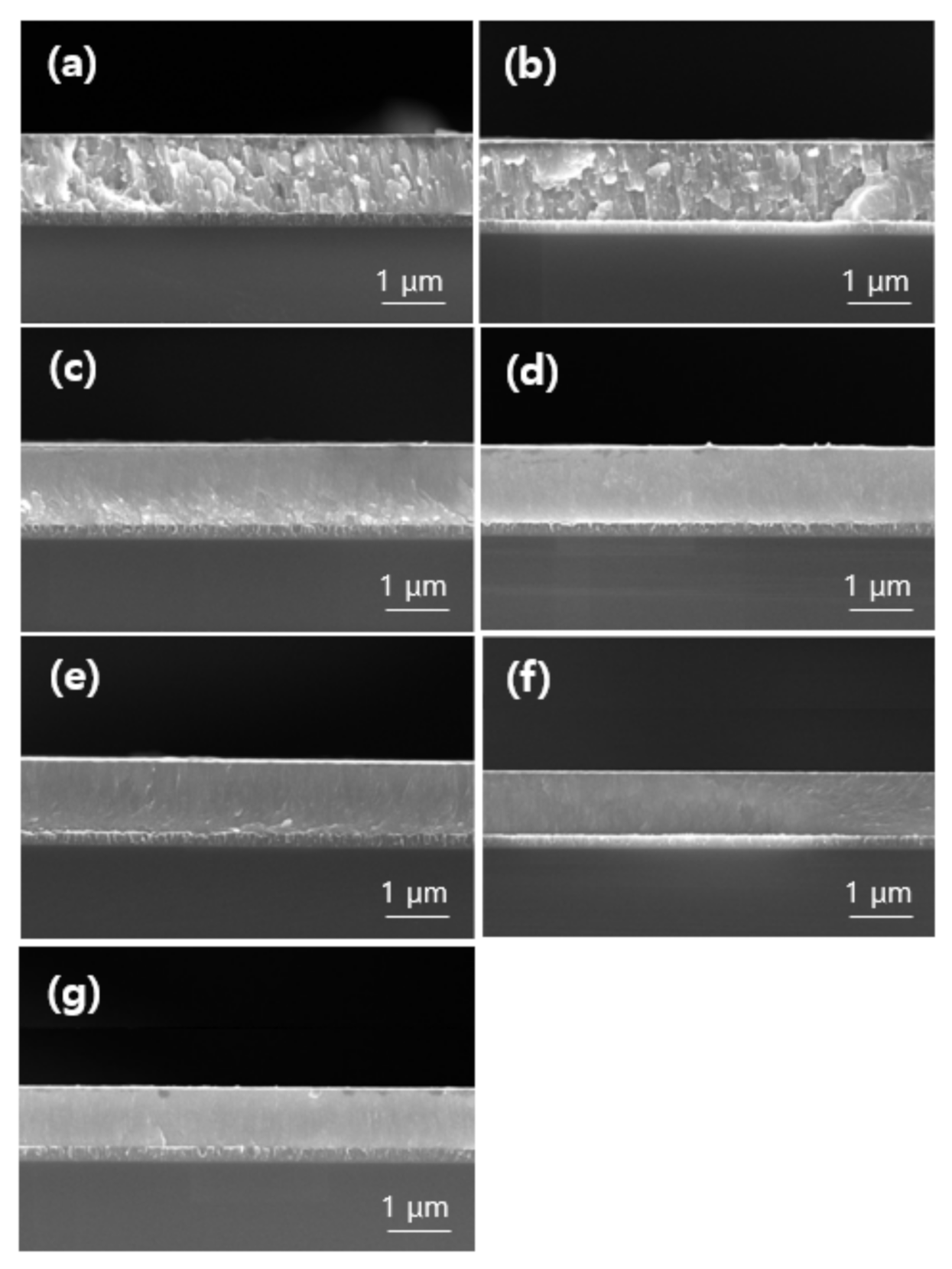
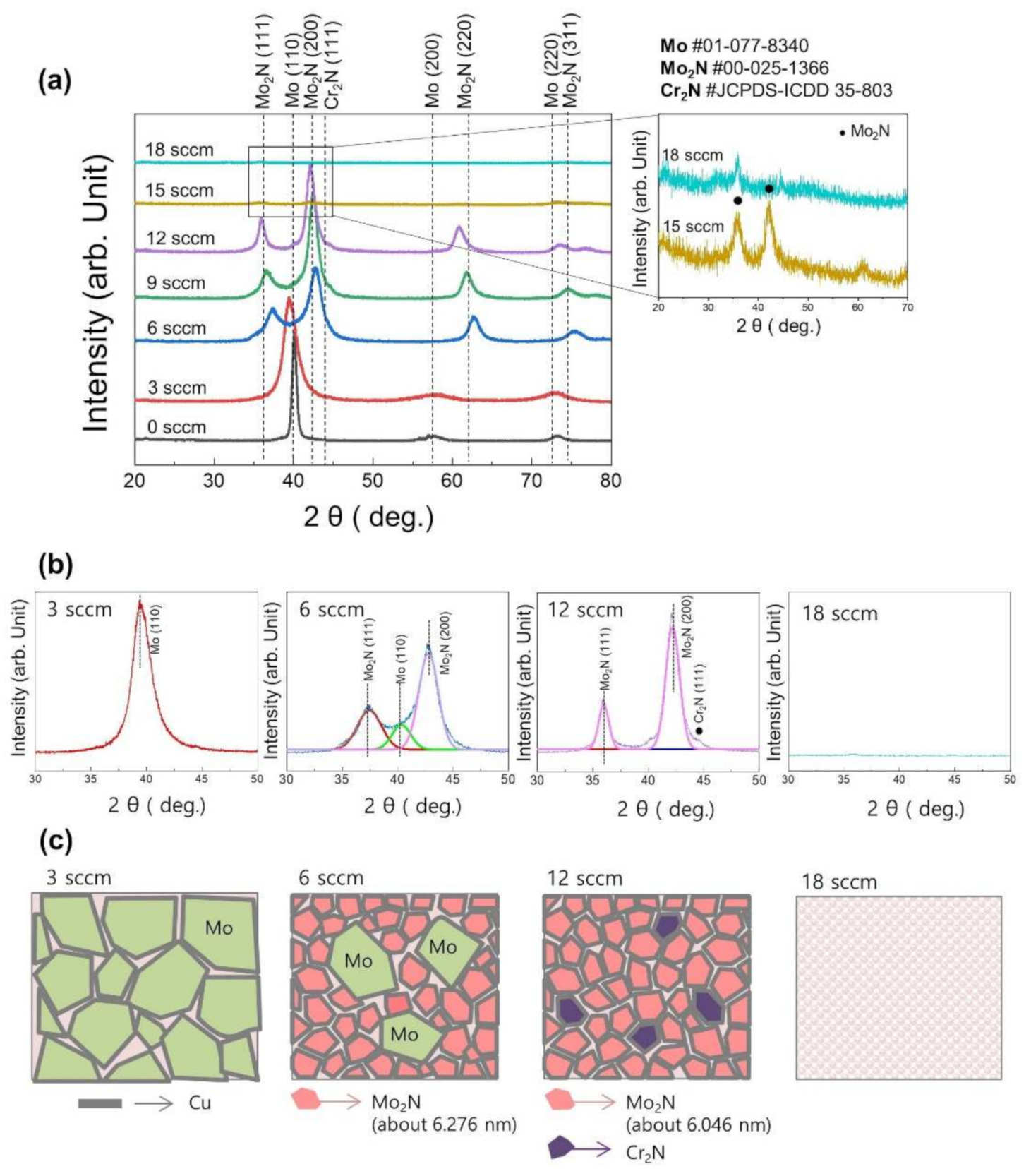
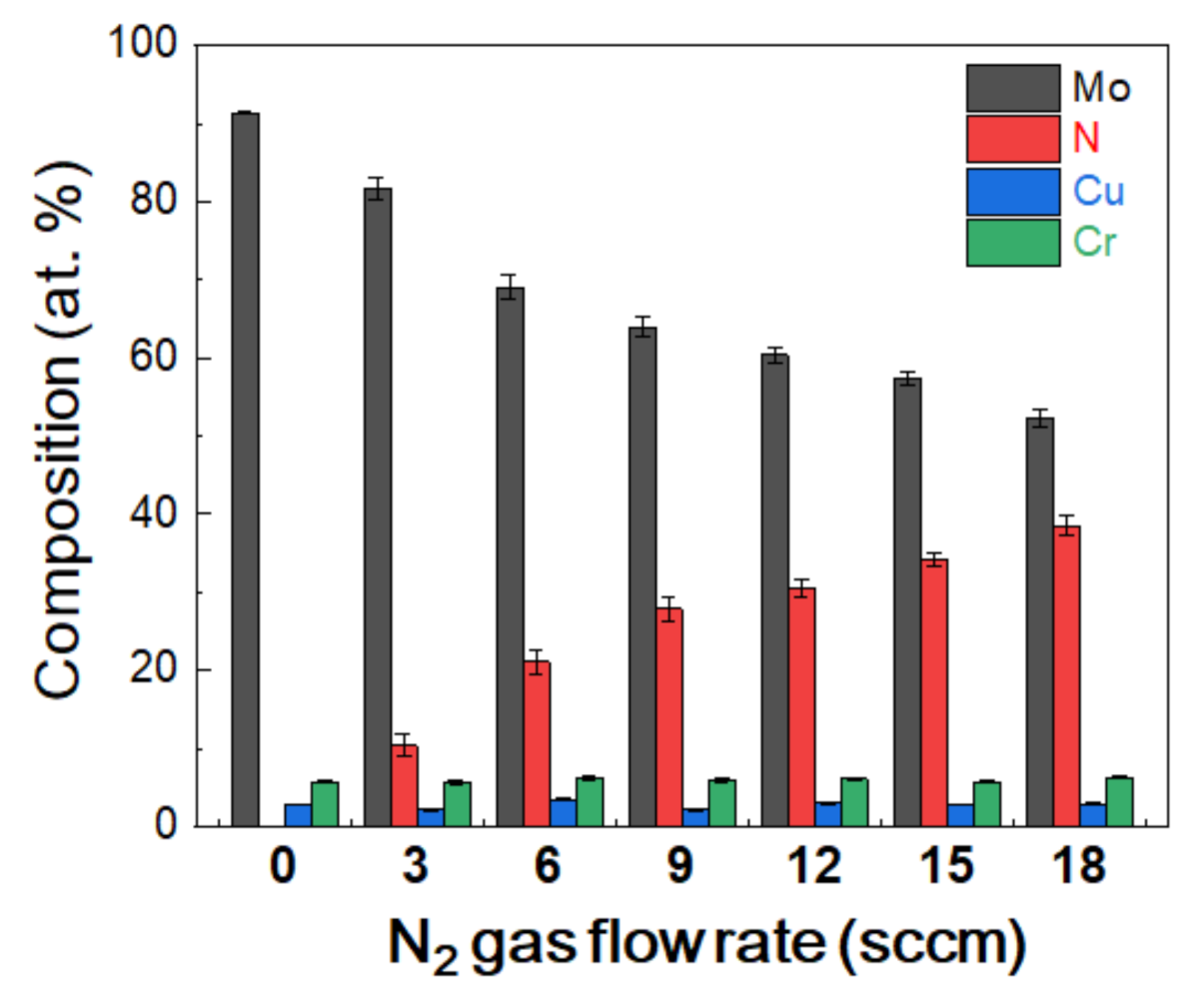
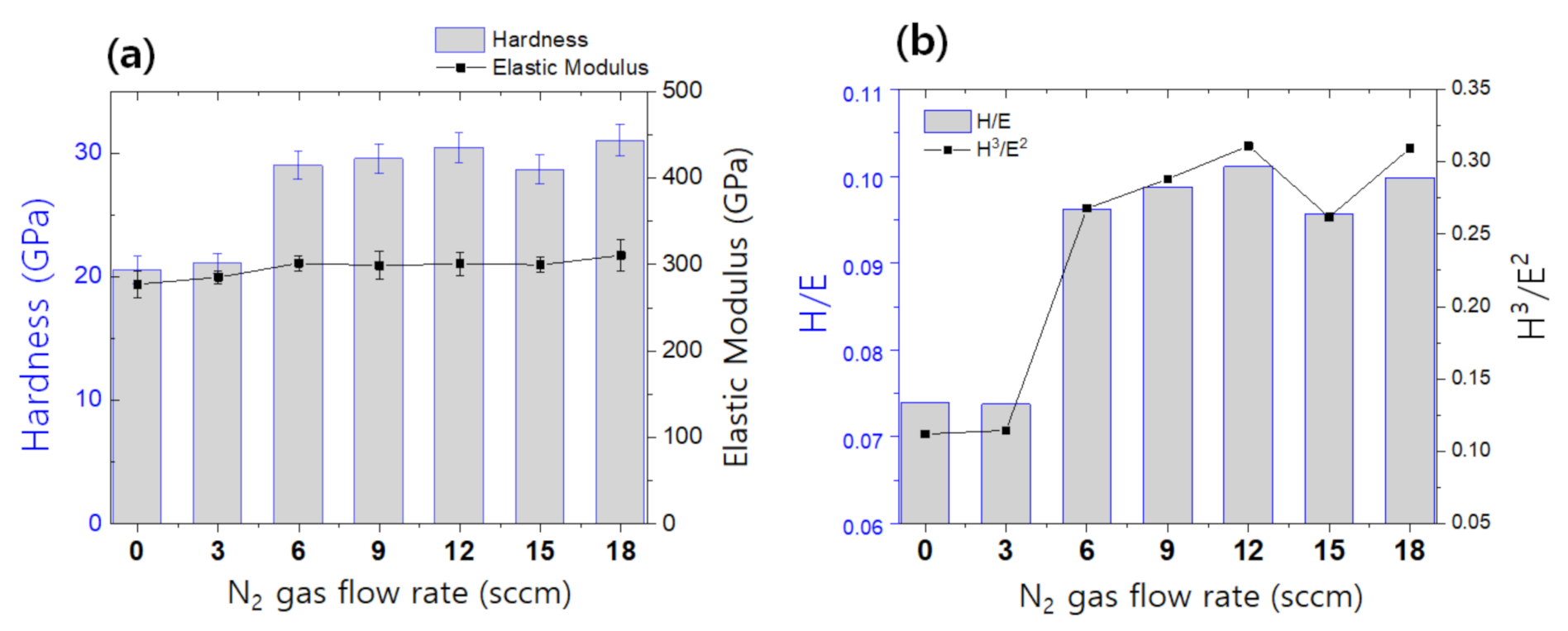
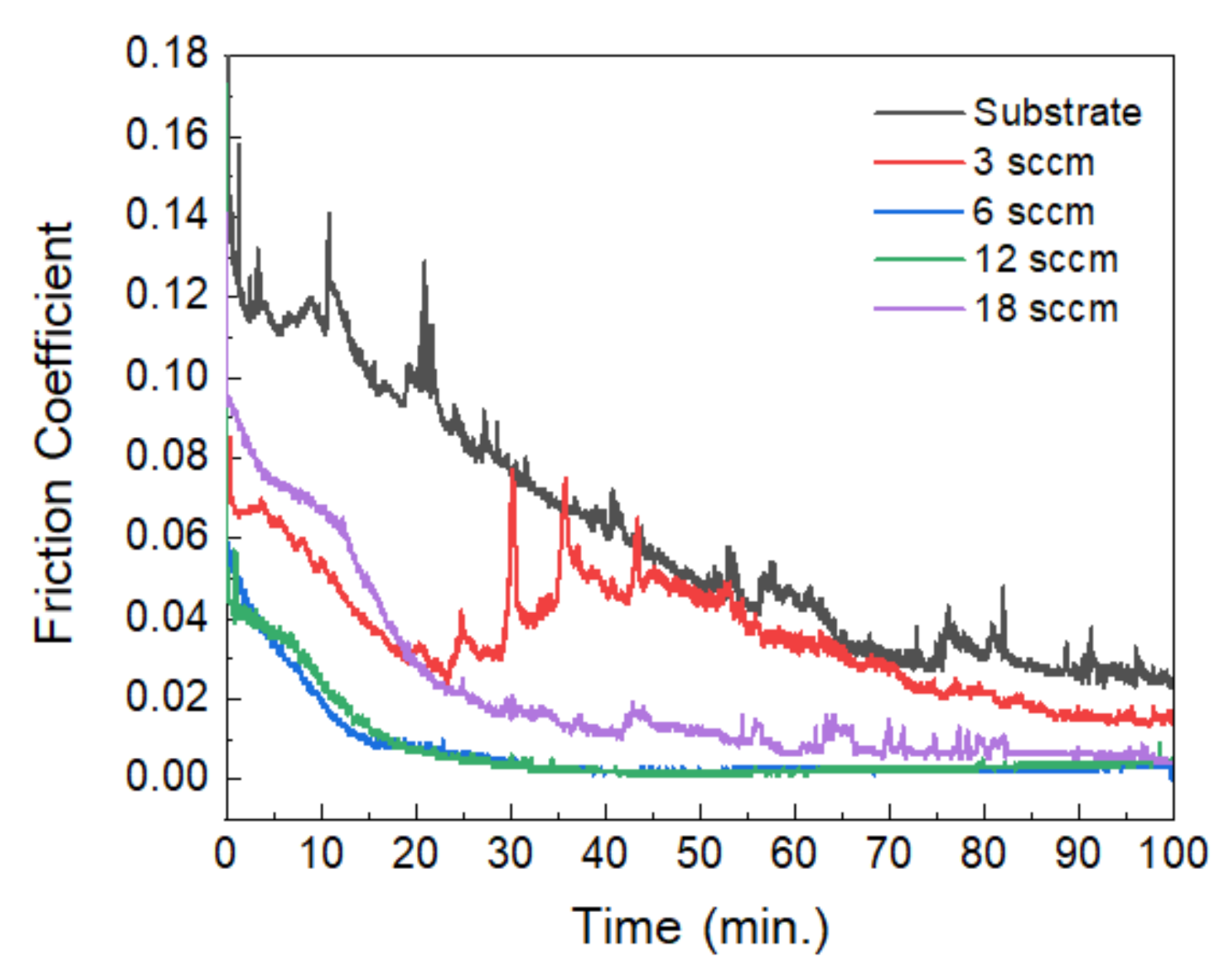
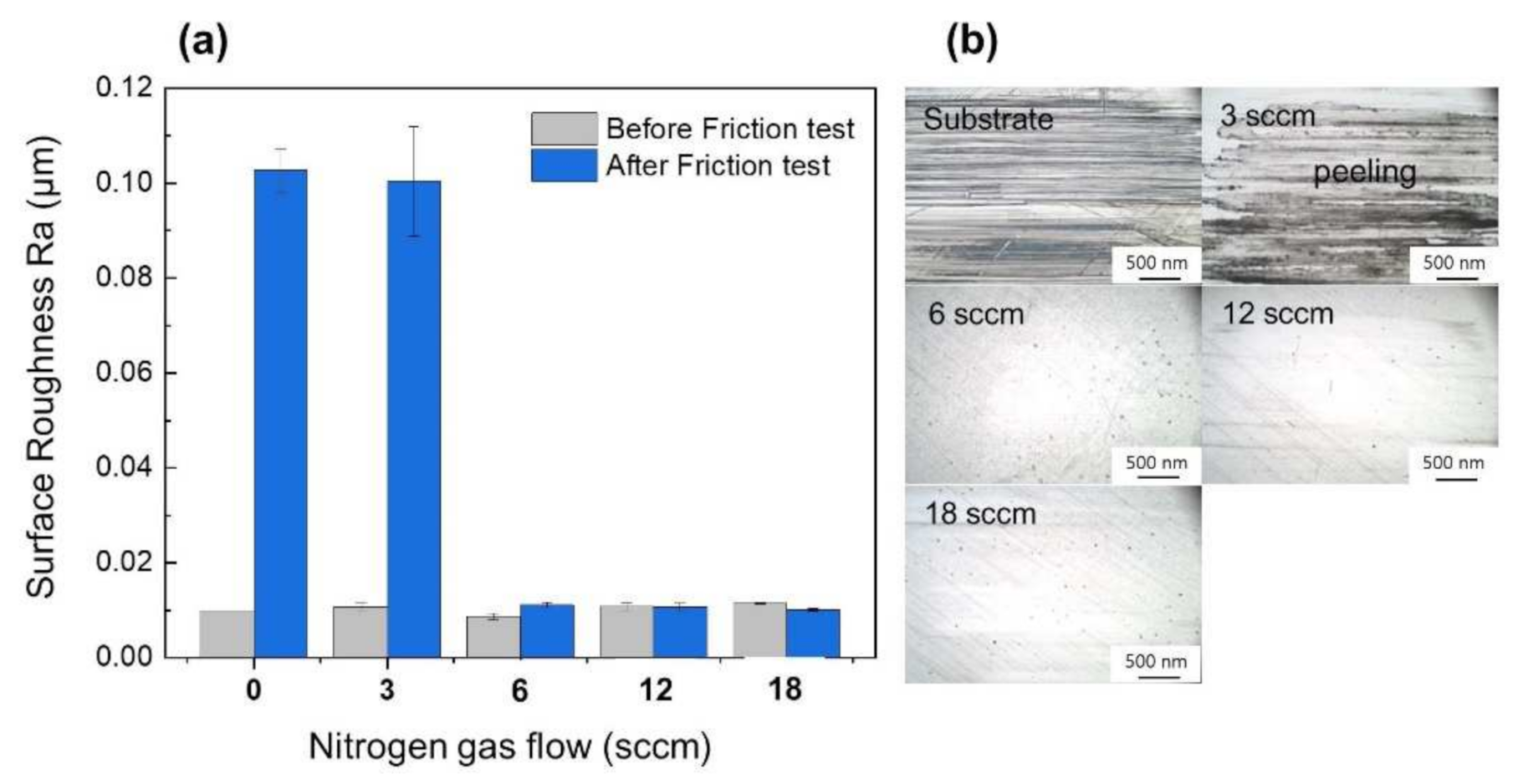
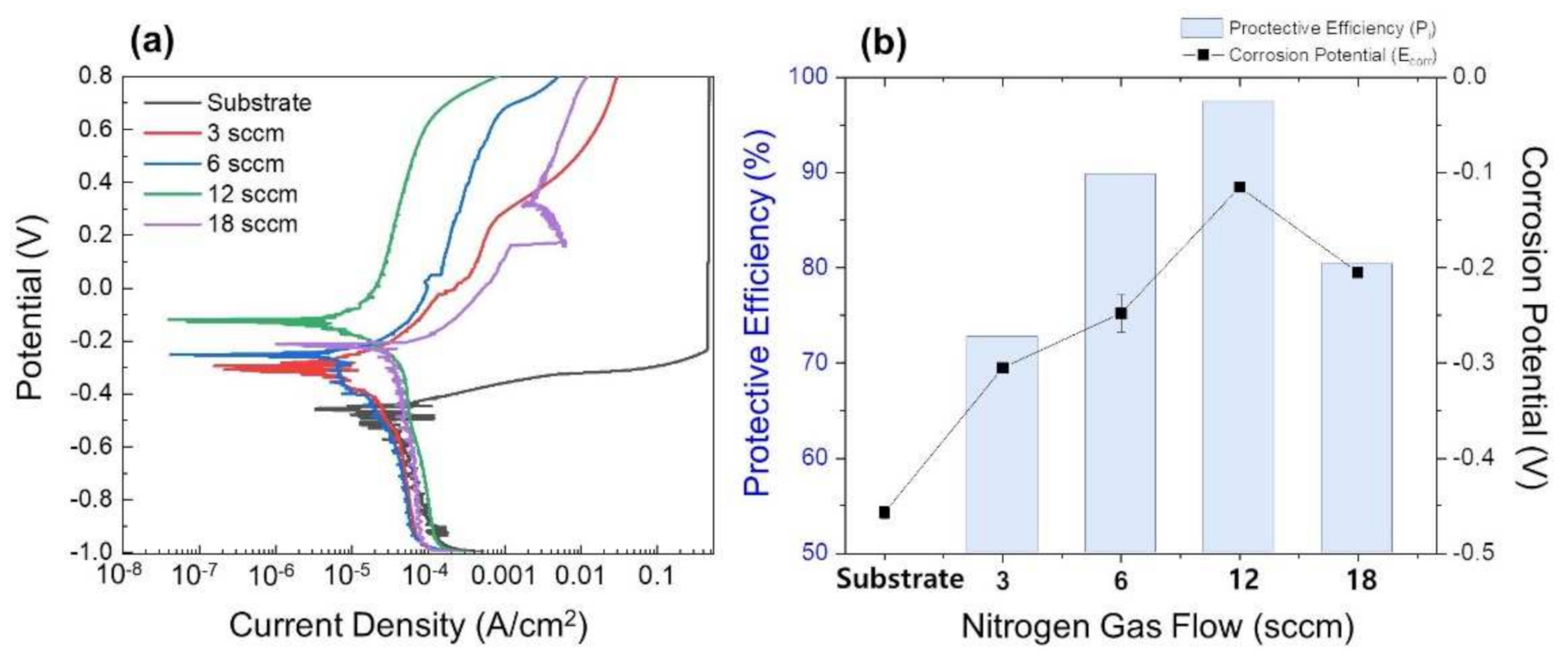

Publisher’s Note: MDPI stays neutral with regard to jurisdictional claims in published maps and institutional affiliations. |
© 2022 by the authors. Licensee MDPI, Basel, Switzerland. This article is an open access article distributed under the terms and conditions of the Creative Commons Attribution (CC BY) license (https://creativecommons.org/licenses/by/4.0/).
Share and Cite
Kim, S.; An, K.W.; Yoon, H.W.; Park, H.J.; Moon, K.I.; Lee, C.S. Evaluation of Sputtered Mo–Cu–Cr–N Coatings Prepared at Different N2 Gas Flow Rates Using a Multicomponent Single-Alloy Target. Coatings 2022, 12, 371. https://doi.org/10.3390/coatings12030371
Kim S, An KW, Yoon HW, Park HJ, Moon KI, Lee CS. Evaluation of Sputtered Mo–Cu–Cr–N Coatings Prepared at Different N2 Gas Flow Rates Using a Multicomponent Single-Alloy Target. Coatings. 2022; 12(3):371. https://doi.org/10.3390/coatings12030371
Chicago/Turabian StyleKim, Soobyn, Ki Won An, Hae Won Yoon, Hyun Jun Park, Kyoung Il Moon, and Caroline Sunyong Lee. 2022. "Evaluation of Sputtered Mo–Cu–Cr–N Coatings Prepared at Different N2 Gas Flow Rates Using a Multicomponent Single-Alloy Target" Coatings 12, no. 3: 371. https://doi.org/10.3390/coatings12030371
APA StyleKim, S., An, K. W., Yoon, H. W., Park, H. J., Moon, K. I., & Lee, C. S. (2022). Evaluation of Sputtered Mo–Cu–Cr–N Coatings Prepared at Different N2 Gas Flow Rates Using a Multicomponent Single-Alloy Target. Coatings, 12(3), 371. https://doi.org/10.3390/coatings12030371






